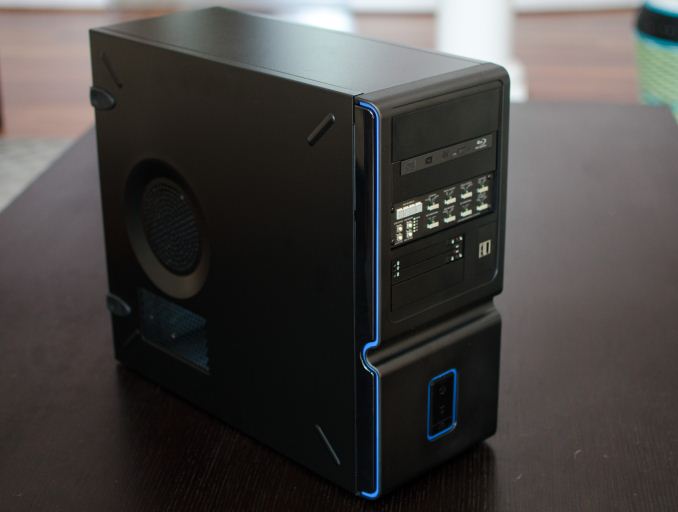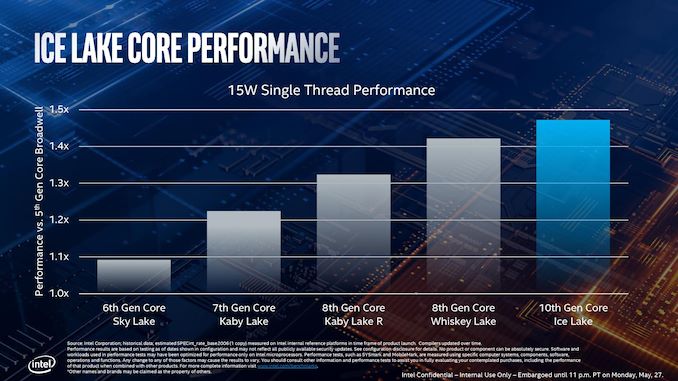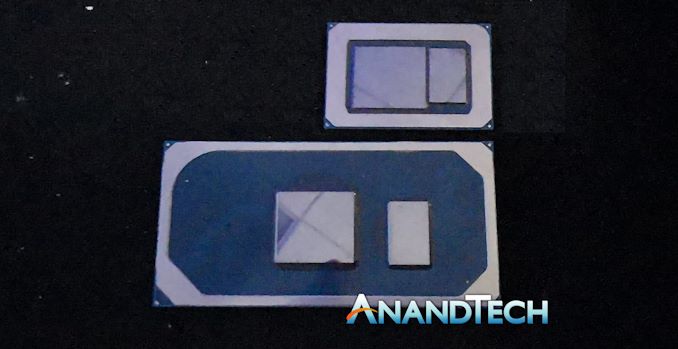The Ice Lake Benchmark Preview: Inside Intel's 10nm
by Dr. Ian Cutress on August 1, 2019 9:00 AM EST- Posted in
- CPUs
- Intel
- GPUs
- 10nm
- Core
- Ice Lake
- Cannon Lake
- Sunny Cove
- 10th Gen Core
Conclusions
First of all, I must say that Intel offering us to test a reference system in advance of a launch is a very good thing indeed. It is not something that Intel has done often in the past – in fact the last time I remember it happening was with Broadwell, when Intel sampled us one of their mobile CRB (consumer reference board) systems for the 45W chip. Before that, Intel had a small attempt allowing the press to benchmark Conroe in 2006 with canned pre-provided benchmarks, which did not go down to well. So moving into this pre-testing regime gets some immediate kudos to those who approved the testing.

Intel’s Broadwell / Crystalwell Mobile CRB
Given that the Ice Lake platform is more geared up towards ultra-premium designs, the software development system we ended up testing was certainly a reasonable expectation and direction that these parts would go in. Of course, we only had the best part of nine hours to test, and giving us the option to test both 15W and 25W modes meant we had to pick and choose what tests we thought were relevant. My most prominent feedback to Intel would be to give us two days to test next time, as it allows us to sit on our data after day one and decide what to do next. It was clear that some of the press in attendance only needed a day (or half a day), but for what we do at AT, then two days would be better.
As for Ice Lake itself, our results lean towards Ice Lake outperforming Whiskey Lake, if only by a small margin.
To preface this, I want to recall a graph that Intel showed off at Computex:
This graph shows the single thread performance of Skylake and beyond, compared to 5th Gen Broadwell hardware. Right at the very end, we see Whiskey Lake performing +42% above Broadwell, and Ice Lake performing +47% above Broadwell. A quick calculation of 1.47/1.42 means that even Intel is only predicting an absolute gain of ~3.5% for Ice Lake over current generation systems.
The reason why the difference is so small is because of IPC and frequency. Intel is touting a median IPC advantage on the new Sunny Cove cores of +18% against Skylake. That isn’t something we were able to test in the short time we had with the system, but +18% should provide a healthy bump – we actually see a number of key microarchitectural improvements bubble up through in our SPEC testing.
But at the same time, the frequency has decreased – our Whiskey Lake Huawei Matebook system was +500 MHz on the base frequency (+38%), and +700 MHz on the turbo frequency (+18%). If it were not for the vast increase in memory speed, moving from LPDDR3-2133 to LPDDR4X-3733, one might have predicted that the Core i7-1065G7 Ice Lake processor and the Core i7-8565U Whisky Lake processor would have performed equally.
The question here then becomes whether you prefer IPC or frequency. For instruction limited tasks, that answer should be IPC. For critical path limited tasks, you nominally require frequency. All this gets muddled a bit with the increased memory frequency, but with higher IPC at lower frequency, you should arguably be more power efficient as well, leading to longer battery life. At iso-performance between Ice and Whiskey, considering no other factors like price, I would choose Ice.
Intel has made a number of improvements to a chunk of the instruction set that should work well for users, however the new bigger cache design has added a bit of latency there, which ends up being a bit of give and take with cache hits and misses.
Of course, the one area where Ice Lake excels in is graphics. Moving from 24 EUs to 64 EUs, plus an increase in memory bandwidth to >50 GB/s, makes for some easy reading. It gets even better in 25W mode, for games that are CPU limited, but still don’t expect to be tackling AAA games at high resolutions. Despite Ice Lake being focused on the ultra-premium >1080p resolution market, you will still be gaming at 720p or 1080p at best here.
The other alternative is to attach a Thunderbolt 3 external graphics card. If there’s one really good add-in to Ice Lake, aside from the graphics uplift, it’s the inclusion of up to four TB3 ports as part of the CPU silicon. If and when the TB3 controllers get a lot cheaper on the device side, this should really help accelerate a high-performance standard here.
We should also talk about AVX-512 – Intel is in a position right now where including it in the chip uses a good amount of die area, and the software ecosystem hasn’t yet adopted it. By advertising speed-ups like DLBoost, the company is hoping to entice developers to work with AVX-512 in mind, and improve a number of machine learning applications for consumer processors. The other side there is what sort of consumer applications need machine learning that isn’t already done in the cloud. It’s a bit of a catch-22, but in our own testing, the AVX-512 does provide a significant speed-up. However, given Intel’s recent mantra of testing for user experience, it will be interesting to see how hammering the AVX-512 unit meshes with that mantra.
The scope of when these Ice Lake processors are coming to market, and how much, is still a question mark. Intel states that we’ll see Ice Lake in the market for the holiday season (i.e. Christmas), however we have a number of trade shows around the corner, such as IFA in September, where me might start seeing some companies start to show off their designs. We also know that Intel plans to release Comet Lake mobile processors sometime this year, on the old 14nm process and old Skylake-based microarchitecture, but at higher frequencies, so it will be interesting to see how they compete.
Final Thoughts
I’m glad to have tested Ice Lake. It’s a shame that we only had a day to test, because I could have spent a week testing that system. Increasing IPC is the best problem to solve, even if it gives similar performance due to a lower frequency, but hopefully the knock on effect here will be better battery life for users at the same performance. Once we get some systems in to test that battery life, and Project Athena’s requirement of 16+ hours comes to the front, I think we’ll see the best examples of Ice Lake shine through.













261 Comments
View All Comments
Phynaz - Friday, August 2, 2019 - link
What? TDP doesn’t mean what you think it does.Alexvrb - Monday, August 5, 2019 - link
I didn't feel like quoting the entire paragraph. But please DO elaborate. Then tell me how useful TDP is when they let OEMs set PL2 and Tau to... anything, really. You can take two "95W" processors and their power and thermals under load are radically different across a range of mainboards. The is reflected in mobile as well, where they let OEMs do pretty much whatever - the results aren't constrained by the processor no matter what the claimed TDP is. That doesn't even COUNT overclocking.Meanwhile AMD chips don't hand over control to mainboards unless you ARE overclocking, which is how it SHOULD be.
Alistair - Friday, August 2, 2019 - link
I didn't see any discussion or comparison vs. the i7-9850H. Let's see a 28W TDP version of the 6 core i7-9850H put against these new chips. Same money, 50 percent more cores. Anyone in their right mind should be looking for an i7-9850H or 9750H laptop instead over these 10nm products. Where is the 6 core 10nm CPU? Don't buy a 4 cores laptop if you're looking for good performance in 2019-2020 imo.If you want a 4 core laptop get a cheaper 14nm based laptop. If you want performance get a 6 core. I really really don't see the point in these products.
Alexvrb - Friday, August 2, 2019 - link
They gotta do *something* with all those 10nm wafers. Ian can't eat them all, and China said they don't want any more half-baked 10nm products after the last go-around. Maybe in 2020 we'll see 10nm++ and it will be as good as phase one 10nm was supposed to be.But yeah, their current 10nm products are a bit disappointing outside of the fatter GPUs and better memory speeds. If you're using something with a dGPU there's little point vs their own 14++, it only starts to make sense if you want AMD-like iGPU performance with the latest Core processor design. Even then that's only limited to models with a high EU count (48+) as the 32 EU models just look meh.
They're going to have some stiff competition when 7nm Zen 2 APUs launch. I guess that's why they're attacking the low-power first, as AMD is still stuck on 12nm rehash Zen+ products for now.
InvidiousIgnoramus - Friday, August 2, 2019 - link
I still find it amusing that the architecture with "Ice" in it's name has low clock speeds presumably from power/heat issues.abufrejoval - Friday, August 2, 2019 - link
Great work! And kudos to AMD to make Intel work so much harder to get good news out!Two die carrier layouts but the chips looking identical:
First of all, I assume that the bigger and square chip is essentially the North-Bridge in 14nm?
And the smaller rectangular one the CPU+iGPU?
And I guess at 64EU we are talking about more than 60% of die area going to iGPU while even at quad core and AES-512 the CPU + cache will be perhaps 30%?
Is there any HSA or GPGPU compute to 'pay' for that iGPU surface and power in professional workloads?
Or is it really just for gaming?
Am I also correct to assume that of the extra thermal budget in the 28Watt parts, none really goes to the CPU, only allows it to stay within the 15 Watt envelope while the iGPU is also running?
Are we talking different die layouts and sizes for dual/quad CPUs and 64/32 iGPU EUs or is it really all just binning, meaning that an Core i3-1000G1 is a chip where 70% surface area of an Core i7-1060G7 failed to make it?
Why am I thinking they are heading down a path without consumer value returns?
I got a Lenovo S730 i7-8565U or Whisky Lake recently for a little over €1000 and I got a couple of J5005 Atoms recently for a little over €100 (admittedly complete notebook vs. RAM less Mini-ITX mainboard). The difference in power is 15 vs 10 Watts.
Both are fairly competent 2D machines even at 4k. Both are terrible gaming machines, but I don't really think that ultrabook portable gaming performance is a selling point.
If I were free to choose CPU vs. GPU real-estate, I'd definitely go left, say 6 or 8 CPU cores or just higher sustained turbos and make do with the J5005's 18 iGPU EUs, because CPU power is what I profit from professionally.
For GPU, every € I spend gets me vastly more gaming experience in less mobile form factors, which is fine: I don't see how I could run in a game and outside without breaking my newest toy.
Sahrin - Friday, August 2, 2019 - link
$426 for a quad core in 2019. What a time to be alive.eva02langley - Friday, August 2, 2019 - link
So basically... expensive, low yield, 4 cores, low frequency.Outside of better IGPU, barely matching AMD offering, and AVX512, which is not even a matter for a 4 cores CPU, 10nm is an abysmal failure.
Phynaz - Friday, August 2, 2019 - link
So basically....you’re an imbecileKorguz - Friday, August 2, 2019 - link
your one to talk phynaz, i guess you want to be stuck on quad cores in notebooks for ever ???